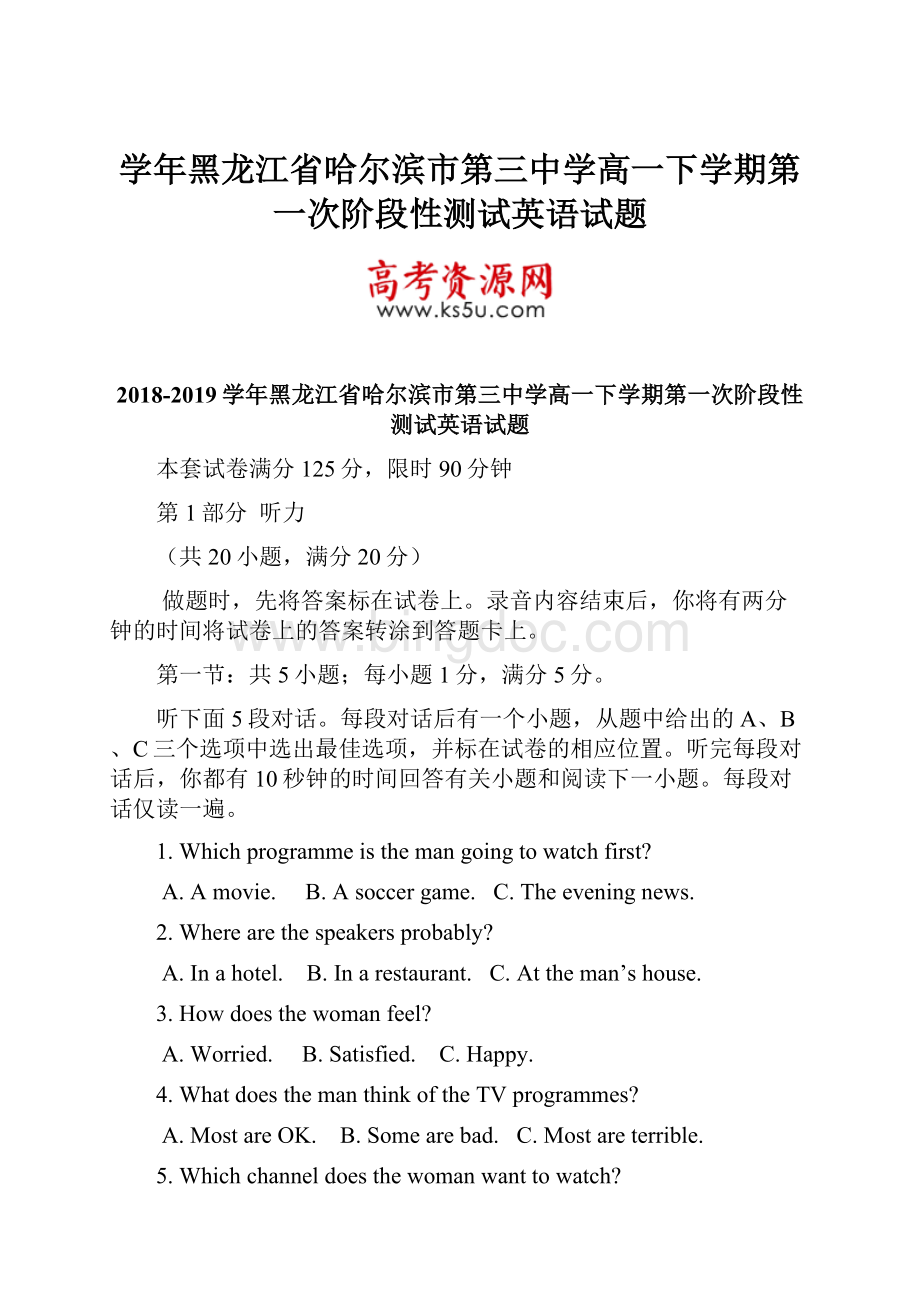学年黑龙江省哈尔滨市第三中学高一下学期第一次阶段性测试英语试题.docx
《学年黑龙江省哈尔滨市第三中学高一下学期第一次阶段性测试英语试题.docx》由会员分享,可在线阅读,更多相关《学年黑龙江省哈尔滨市第三中学高一下学期第一次阶段性测试英语试题.docx(16页珍藏版)》请在冰点文库上搜索。

学年黑龙江省哈尔滨市第三中学高一下学期第一次阶段性测试英语试题
2018-2019学年黑龙江省哈尔滨市第三中学高一下学期第一次阶段性测试英语试题
本套试卷满分125分,限时90分钟
第1部分听力
(共20小题,满分20分)
做题时,先将答案标在试卷上。
录音内容结束后,你将有两分钟的时间将试卷上的答案转涂到答题卡上。
第一节:
共5小题;每小题1分,满分5分。
听下面5段对话。
每段对话后有一个小题,从题中给出的A、B、C三个选项中选出最佳选项,并标在试卷的相应位置。
听完每段对话后,你都有10秒钟的时间回答有关小题和阅读下一小题。
每段对话仅读一遍。
1.Whichprogrammeisthemangoingtowatchfirst?
A.Amovie.B.Asoccergame.C.Theeveningnews.
2.Wherearethespeakersprobably?
A.Inahotel.B.Inarestaurant.C.Attheman’shouse.
3.Howdoesthewomanfeel?
A.Worried.B.Satisfied.C.Happy.
4.WhatdoesthemanthinkoftheTVprogrammes?
A.MostareOK.B.Somearebad.C.Mostareterrible.
5.Whichchanneldoesthewomanwanttowatch?
A.Channel2.B.Channel4.C.Channel9.
第二节:
共15小题;每小题1分,满分15分。
听下面5段对话或独白。
每段对话或独白后有几个小题,从题中所给的A,B,C三个选项中选出最佳选项,并标在试卷的相应位置。
听每段对话或独白前,你将有时间阅读各个小题,每小题5秒钟;听完后,各小题将给出5秒钟的作答时间。
每段对话或独白读两遍。
听第6段材料,回答第6至8题。
6.Whatistheprobablerelationshipbetweenthespeakers?
A.Teacherandstudent.
B.Bossandemployee.
C.Doctorandpatient.
7.Howlonghasthemanworkedhere?
A.Forjustayear.B.Overayear.C.Lessthanayear.
8.Whydoesthewomansaysorrytotheman?
A.Heissick.B.Heoftenworksovertime.C.Sheforgetstogivehimaraise.
听第7段材料,回答第9至11题。
9.Wherewasthewomanborn?
A.InNanjing.B.InQingdao.C.InSuzhou.
10.Wheredidthewomangotohighschool?
A.InNanjing.B.InQingdao.C.InSuzhou.
11.Whatisthewomangoingtodoaftergraduation?
A.Goabroad.B.Gotowork.C.Goonwithhereducation.
听第8段材料,回答第12至14题
12.Whatistherelationshipbetweenthespeakers?
A.Policemanandagirl’smother.
B.Shopassistantandcustomer.
C.Teacherandstudent.
13.Howtallisthemissinggirl?
A.115cm.B.150cm.C.155cm.
14.Wherewasthemissinggirl?
A.Atthepolicestation.
B.Inthecornerofthedepartmentstore.
C.Atthecornerofthestreet.
听第9段材料,回答第15至17题。
15.Whatdidthemanorder?
A.Chickensoup.B.Potatosoup.C.Eggsoup.
16.Whydoesthemansay“I’llseeyourmanager”?
A.Thepotatosoupistoohot.
B.Hewantstohaveabusinesstalkwiththemanager.
C.Heisnotsatisfiedwiththefoodandtheservice.
17.Whatcanweinferfromtheconversation?
A.Chickensoupisverycheapintherestaurant.
B.Theserviceintherestaurantispoor.
C.Thecustomerpreferspotatosoup.
听第10段材料,回答第18至20题。
18.HowmanygrandchildrendoesMrsNikohave?
A.5.B.6.C.41.
19.WhatdoesMrsNikkousuallydoeverymorning?
A.Goswimming.B.Gofishing.C.Goforlongwalks.
20.WhatthingsdoesMrsNikkoavoid?
A.Beerandsugar.B.Coffeeandtea.C.Fruitandcoffee.
第二部分:
阅读理解(共两节,满分40分)
第一节(共15小题;每小题2分,满分30分)
阅读下列短文,从每题所给的四个选项(A、B、C和D)中,选出最佳选项,并在答题卡上将该项涂黑。
A
Allchildrenarenaturallymusical!
RockyMountainCenterforMusicalArtsoffersarangeofmusicalcoursesfortheearliestbeginnersthroughage6.Whileachildishavingfunsinging,listening,moving,andplayingmusicalinstruments,he/sheisalsodevelopinganunderstandingofmusicalconceptssuchashigh/low,fast/slow,andsoft/loud,aswellasvaluablesocialskills.Nowitistimetogivechildrenthebestmusicalbeginning.
MUSICTOGETHER
MusicMovementclassesfortoddlersandpreschoolers.Songs,Chants,Movement,MusicalInstrumentPlayMixed.ForAges:
birth~5yearswithparents/caregivers.
MusicTogetherisaninternationallyrecognizedearlychildhoodmusicprogram,offeringfunmusicalexperiencesforyoungchildrenandtheirparents,grandparents,orcaregivers.MusicTogetherisdesignedtodevelopeachchild’sbasicmusicalability.Infants,8monthsandundermayattendclassesforfreewithanenrolled(被录取的)brotherorsister.
Day/Time:
Weekdays9a.m.~9:
45a.m.
Springterm:
Apr.2~Jun.4;EnrollbyMar.9andreceive$5discount!
Fallterm:
Sept.12~Nov.14;EnrollbyAug.26andreceive$5discount!
Winterterm:
Jan.9~Mar.12;EnrollbyDece.16andreceive$5discount!
Tuitionforeachterm:
$170
Clickheretoenrollnow!
MEETWITHINSTRUMENTS
Musicalinstrumentplayingclassesforpreschoolers.Exploremusicalinstrumentssuchaspiano,violin,guitar,drums,flutes,saxophone…
Forages4~6(withaparentorcaregiver).
Day/Time:
Fridays3:
15p.m.~4p.m.
SummerTerm:
Jun.8~Jun.29
Fallterm:
Oct.7~Oct.28
Winter/SpringTerm:
Feb.3~Feb.24
Tuition:
$55perterm
Thisschooldoesn’tsupplymusicalinstruments.Learnersshallbringorhiremusicalinstruments.
Clickheretoenrollnow!
21.Accordingtothefirstparagraph,earlychildhoodmusiceducationhelpschildren________.
A.learnforeignlanguagesB.communicatewithothers
C.developtheirimaginationD.becomewell-knownmusiciansinthefuture
22.Theunderlinedword“toddlers”inparagraph2refersto_________.
A.babieswhoarelearningtowalkB.teenagerswhoattendhighschools
C.grown-upswhoarefondofmusicD.adultswhotakecareofchildren
23.HowlongdoeseachtermofMUSICTOGETHERlast?
A.About4weeks.B.About10weeks.
C.About15weeks.D.About20weeks.
24.Ifachildof3yearsoldwantstoattendwintertermofMUSICTOGETHERandenrollsonDecember10,howmuchwillhepayforthetuition?
A.$55.B.$110.C.$165.D.$170.
25.WhichofthefollowingisTRUEofMEETWITHINSTRUMENTS?
A.Thecourseisdesignedforchildrenunder3.
B.Childrencanusetheschool’smusicalinstrumentsforfree.
C.Childrenshallattendthecourseinthepresenceofoneoftheirparentsorcaregivers.
D.LearnerscanenjoyafavoredtuitioniftheyenrollbeforetheEnrollmentdeadline.
B
Onlineschoolingisbecominganincreasinglypopularchoiceformanystudentsacrosstheworld.Arecentreportfoundthatmorethan6.3millionstudentsintheUStookatleastoneonlinecourseinfall2018,a5.6percentincreasefromlastyear.
Asmoreandmorestudentschoosetostudyonline,somedigitalcommunitiesappear,justliketheywoulddoinatraditionalschool.Onlinecourseoffersmorethanjustaneducationbehindacomputerscreen;buildingrelationshipswiththosearoundyouviatechnologyprovidesarichlearningexperience.Accordingtothereport,77%ofteachersthinkhighlyofonlinecourses.Theybelievethatonlinelearningisasstrictastraditionallearningandbenefitsstudentsalot.Theycangainmoreknowledgeandgetmoremeaningfulinformation.Nearly70%ofallstudentsfindonlineclassesasgoodasorbetterthantraditionalclassroomclasses.Anincreasingnumberofuniversitiesareofferingonlinecourses,too.Studiesshowthat62.4%ofhighereducationschoolsofferedatleastoneonlineprogram.
Forcollegestudents,onlinelearningisacost-effectivechoice.Theadvantagecostofatraditionaldegreeis$85,000,whiletheaveragecostofanonlinedegreeis$30,000.
Onlinelearningtools,suchase-booksandotherresources,areanotherbenefitofdistancelearning.Unlikeheavytextbooks,e-booksareeasytocarryandcanbeusedonasmartphoneoralaptop.E-booksandvideosarealsogreatchoicesforlearnerswhomayfindthetextineffective.Asmoreandmorecollegesofferonlinecourses,qualityonlineeducationisbecomingincreasinglyaccessible.Forstudentswhosefamiliesareinanever-changingenvironment,theseonlineclassesarethemostbeneficial.Theyallowthosestudentstoenjoytheirlifestylewhilecontinuingtogrowsociallyandprofessionally.
26.Howmanystudentstookonlinecoursesin2017intheUS?
A.About5million.B.Around6million.
C.Lessthan5.6million.D.Morethan6.3million.
27.WhatdoseParagraph2mainlytalkabout?
A.Thewaystostudyonlineefficiently.
B.Theadvantagesofstudyingonline.
C.Themethodofchoosingonlinecoursesproperly.
D.Theadvantagesoftraditionalclassroomclasses.
28.Whatdosetheauthorwanttoshowinparagraph3?
A.Onlinelearningispopular.B.Onlinelearningiseffective.
C.Onlinelearningisconvenient.D.Onlinelearningismoney-saving.
29.Accordingtothepassage,whocangetthemostbenefitfromdistancelearning?
A.Peopleworkingasprofessors.
B.Peopledislikingcollegecourses.
C.Peopleoftenchangingtheirlivingplaces.
D.Peoplegettingagooduniversityeducation.
30.Whatdosetheunderlined“They”inthelastparagraphreferto?
A.E-books.B.Qualityonlineclasses.
C.Learningtools.D.Asmartphoneoralaptop.
C
Whichofyourchildrenisyourfavorite?
Yourresponseisprobably“noneofthem”.Whatkindofparentwouldchooseonechildashisorherfavorite?
Thetruthmightbesurprisingtoyou.
Yearsofresearchsupportswhatmanyhavesuspected—mostparentshaveafavoritechild.Studieshaveexploredreasonsfrombirthordertogenderandsharedinterests.Yetevenwithyearsofresearchthatsupportsthisidea,mostparentstendtodenythefactthattheyhaveafavoritechild.Evenifthereisnoobviousparentalfavoriteamongsiblings(兄;弟;姐;妹),studieshaveshownthatchildrenoftenfeelpreferential(优待的)treatmentoftheirsiblingbytheirparents.Favoritism(偏袒)oftenresultsinfamilyconflictandfeelingsofsadnessamongfamilymemberswheretheirparents’favoritismisrealoronlyfelt.Thusboththekidandtheirparentstendtobeplaguedbythefavoritism.
Thequestionisn’twhetherornotyouhaveafavoritechild,sinceit’sprettyclearthatmanyparentsdo.Typically,favoritismhaslittletodowithlovingonechildmore.Itismoreabouthowyourpersonalityresonates(产生共鸣)withonechild’spersonalitymorethantheothers’.Essentially,it’saquestionof“like”.
Still,whyisitsohardforustoadmitthatone